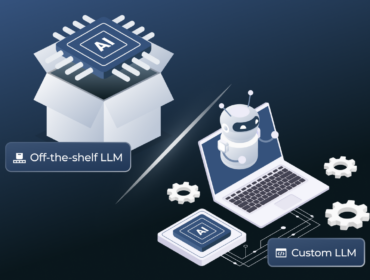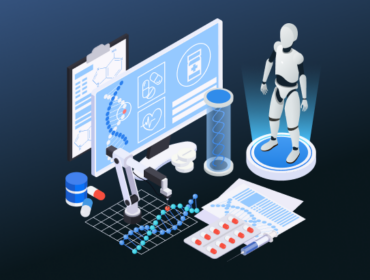Retailers must study their target audience to deliver a more personalized shopping experience and provide high-quality support. You can learn more about your customers with artificial intelligence (AI) and, more specifically, with machine learning in your retail business.
According to the 2022 Mordor Intelligence report, AI is no longer a novelty for modern retailers. About 80% of retail companies in the US are expected to have advanced analytics and machine learning capabilities by 2025 (up from 40% in 2022). But despite so many retailers adopting them, we can’t say they all leverage it effectively. Why? Because it’s not just about having this technology; it’s more about how you use it.
So, how can these technologies further your business goals? This article tells you about successful applications of machine learning in retail with examples from real companies. We’ll also tell you how our company implements algorithm-based tools for our clients.
Advantages of machine learning for retail businesses by the numbers
Machine learning is a set of AI algorithms that train with sample data to improve their function. It does so using principles of supervised learning (the software predicts outcomes based on labeled training datasets provided by data scientists) and unsupervised learning (the algorithm detects patterns in unlabeled input data).
In retail, machine learning algorithms help streamline and automate processes, classify data, segment customers, make predictions, and provide recommendations. Here are some numbers that show how implementing advanced algorithms can improve your business:
- Forecasting abilities. Machine learning tools give your AI system more means to capture, structure, and analyze customer data to improve prediction accuracy. Surveyed companies using machine learning algorithms report improvements of over 13% in demand accuracy and about half as many prediction errors.
- Productivity boost. Rule-based algorithms can automate routine operations (like invoice management and product categorization) to augment your employees’ productivity. According to the 2020 IDC research report, technologies like machine learning will automate or augment up to 45% of repetitive tasks by the end of 2022. This has the potential to enhance productivity by nearly 40% in developed countries by 2035.
- Personalized experiences for customers. With machine learning, retail companies can learn more about their customers’ interests based on past purchases, location, search queries, and other information. Your AI system can then develop customer profiles based on their preferences to craft tailored offers. According to McKinsey’s 2020 report, 17% of companies using machine learning do it for customer analysis, and 14% use it to segment their audience.
- Enhanced customer service. Nearly 70% of your potential customers might decide not to purchase from your company if they encounter long wait times for customer service. But implementing machine learning-based chatbots can cut your average response time to just seconds. Based on Deloitte’s 2019 study, conversational AI increases customer satisfaction, reduces customer churn, and cuts up to 70% of customer service costs.
- Reduced costs. A 2021 McKinsey research report showed that early adopters of AI and machine learning for supply chain management improved their inventory levels by 35% and logistic costs by 15%. Additionally, more than a third of the companies reduced their overall costs by over 20%, and 13% had a 13% revenue boost.
- Improved security. The average cost of a data breach rose to $4.24 million in 2021 from $3.86 million a year before. However, according to an IBM report on data breaches, organizations that used automation and fully deployed AI and machine learning for cybersecurity had fewer vulnerabilities and, consequently, paid 80% less for data breaches than companies that didn’t use AI security and automation.
We don’t want to overwhelm you with numbers. So, let’s look at some examples of how companies apply AI and machine learning technologies.
10 applications of machine learning in retail
Retail organizations apply machine learning models for various reasons, depending on their business and goals. Here are some common use cases for your consideration.
-
Inventory optimization
Machine learning algorithms help retailers keep track of their merchandise, identify phantom inventory, and optimize its placement. One example of this use is Amazon’s sophisticated machine learning model that helps organize items, optimize supply, and organize warehouse locations.
Another example of managing inventory with AI is an inventory monitoring app we developed for retail pharmacies. Using a combination of computer vision and machine learning, this system analyzes which medical products and drugs are on shelves. This information is then categorized (based on parameters like product type and brand) and displayed in the app’s dashboard for analysis.
Our team also built shelf revision software for a multinational company. This tool helps companies monitor stock in supermarkets in real-time using computer vision and advanced machine learning algorithms.
-
Targeted offerings
Machine learning software can analyze customer’s online behavior to predict their needs. This helps companies target specific customer segments with relevant product recommendations and ad campaigns, increasing the chance of converting visitors to buyers.
A recommendation system on Steam — the largest video game distribution platform — is a good example of this use. To curate a list of recommended games, a machine learning algorithm analyzes users’ gaming preferences and finds titles played by people with similar tastes.
Another use case of machine learning in retail comes from an Indonesian e-commerce company. Bukalapak combined Google’s machine learning models with its existing product feed to match its best-performing product ads to appropriate audiences. This helped them convert four times more visitors than before implementing the learning models.
-
Cross-selling
Some retailers lack effective techniques to recommend relevant products to purchasers. However, algorithms that learn about buying habits of similar customers can suggest items that complement a user’s purchase that they might not have considered. For instance, a store could recommend a sturdy case or a stylus for a tablet.
Cross-selling algorithms helped the UK retail chain Hobbycraft recommend products their customers might otherwise miss, improving revenue per visit by 4%. Intelligent recommendations also helped Halfords — one of the UK’s largest motoring and cycling retailers — garner a 3% increase in items sold per basket.
-
Automated category management
Poorly categorized websites make it difficult to personalize offerings, target users with ads, and cross-sell products. A well-organized online store, on the other hand, provides more accurate search results and more relevant recommendations.
To achieve better organization, companies in the retail business use machine learning to classify products in their online stores. If you have tens of thousands of items, doing this manually would be a nightmare. But that’s what one of our clients was doing.
As an international retailer, the client needed a solution to organize over 50 thousand products, with dozens more arriving every few days. We built a retail category management software that solved their problem. The machine learning system categorized items based on their names, descriptions, supplier notes, and keywords. This saved a significant amount of money by eliminating the need to hire a team that did this manually.
-
Demand forecasting
About 37% of retailers forecast demand with machine learning based on customer needs, supply chain disruptions, labor shortages, and other factors. For example, the German logistics company DHL uses algorithms to consider over 240 million variables to predict global trends up to three months in advance. Plus, they use natural language processing (NLP) to forecast supply issues by analyzing millions of online posts every day.
For one of our clients, our team enhanced a machine learning model for a leading supply chain and logistics company. The algorithm uses training data and a week’s input to predict product shortages and failures, allowing them to ship products for the upcoming week with over 80% accuracy.
Algorithms have a prominent role in predictive analytics as a whole. We actually have a separate article about machine learning in demand forecasting if you want to learn more.
-
Dynamic pricing
Machine learning helps retailers and e-commerce stores optimize pricing for their products and services. A good algorithm can calculate the best rate for different customer segments, considering competitors’ offers, demand, and seasonal trends.
According to Statista, in 2021, 21% of e-commerce businesses surveyed used dynamic pricing software, with 17% more planning to implement it later in the year. Major platforms, like Amazon and Myntra (an Indian e-commerce platform), whose algorithms calculate prices for specific products based on customer loyalty, use dynamic pricing to optimize sales.
-
Churn reduction
Customer churn prediction is vital for retailers, considering that it costs about five times less to retain existing customers than to acquire new ones. Common prediction methods rely on statistics, which isn’t enough for in-depth analysis. However, machine learning for retail helps companies identify traits of customers who don’t renew subscriptions and the reasons for their dissatisfaction.
Your system might discover that customers who contact your customer support service are more likely to leave. This knowledge can motivate you to find ways to resolve common complaints or offer incentives to retain these customers. Alternatively, you may want to avoid retargeting people with a high churn probability to save on marketing costs.
The on-demand streaming service Audiobooks.com trained its machine learning algorithms on data from over two million users collected over five years of their listening activity, their clicks, recommendation logs, and churn events. This helped the company pinpoint features that led to subscription cancellations and develop effective countermeasures.
-
Customer feedback analysis
Algorithm-based NLP and sentiment analysis software can process massive quantities of customer feedback on social networks, app stores, and support chats to help you understand the needs and concerns of your target audience. Beyond that, it can alert you to new negative posts, so your customer agents can contact dissatisfied clients and try to appease them immediately.
We developed an analytics system capable of collecting and analyzing sentiment in user reviews. This helped our client improve its marketing and loyalty program and grow its revenue by 10% in less than a year after deployment. Additionally, we helped ANAGOG implement NLP and machine learning algorithms that consider customers’ online feedback for targeted marketing.
-
Chatbots
Chatbots and digital assistants powered by machine learning are common in the retail industry, as they can aid customers in situations that don’t require human interaction. Examples include product recommendations, promotion notifications, and troubleshooting simple issues. Gartner predicts that nearly 90% of organizations will use chatbots for customer self-service by the end of 2022.
Retailers can also integrate their business into other automated systems to improve their reach. For example, Google Duplex allows more users to learn about local companies, check for opening hours, and book appointments with a natural-sounding voice assistant.
-
Data breach and fraud prevention
Nearly 35% of retailers adopt security automation software with machine learning to prevent cyberattacks. It also helps identify fraud and protect your customer’s transactions. For instance, AI systems can detect suspicious user behavior (like login attempts from unusual locations, large cash withdrawals, or questionable purchases) and temporarily block access to flagged accounts for further investigation.
Our threat detection solution identifies data anomalies, unauthorized login attempts, email phishing attempts, and other suspicious activities for preemptive mitigation. And our anti-fraud algorithm for a client in France allows its customers to see trust rankings for online shops, which helps users avoid fraud. As a bonus, it locates similar products at a lower price.
By now, you’re probably wondering how you can apply one of these solutions to your business. So, let’s introduce you to our approach.
How to implement AI and machine learning in retail
Implementing machine learning algorithms for your business requires the right strategy and planning. We tailor our development process to each client’s needs, but in general, it consists of the following stages:
- Business analysis. Our teams discuss your needs, pain points, and expectations. Then, we evaluate your existing IT infrastructure, software, business capabilities, and data management policies. Finally, we’ll document the technical requirements and the design specifications for your approval.
- Prioritization. At this stage, we’ll create a detailed project roadmap and confirm it with all relevant stakeholders. Our approach is to gradually implement functionality, starting from the processes that enhance your business the most with minimal resources.
- Data preparation. Algorithms need a lot of data for training, but the data must be appropriately structured and organized for supervised and unsupervised learning. Small and medium-sized companies rarely have enough data on hand, but thankfully, our experts mine and organize the data for you to ensure you have a sufficient quantity.
- Implementation. Our engineers and data scientists build and train models using the technical stack and development methodologies best suited to your project. We also produce a proof of concept and a minimum viable product to validate the machine learning solution before release.
- Deployment and maintenance. After deployment, we continue to perfect your retail machine learning models based on test data, stakeholder input, and user feedback. Our team also attends to system maintenance, performance monitoring, and software upgrades.
Complex machine learning algorithms and other AI-powered technologies require specialized technical knowledge and experience. That’s why you should consider working with a technical partner to develop your project or augment your in-house development team.
Conclusion
AI and machine learning are critical technologies retailers need to remain competitive. Numerous use cases — from personalized recommendations and inventory optimization to customer support and cybersecurity — demonstrate its benefits. With a sufficient volume of high-quality training data, proper application of machine learning algorithms can improve your business’s performance and increase your revenue.
Do you need help figuring out how retail machine learning solutions can benefit your business? Or do you already have an idea that you want to validate cost-effectively? Contact our team today to discuss your project in depth.








![Machine Learning in Retail: Benefits & 10 Use Cases What’s the EU Artificial Intelligence Act and How to Comply? [Webinar]](https://unicsoft.com/wp-content/uploads/2024/03/Cover_1140_v1.1-370x280.png)

